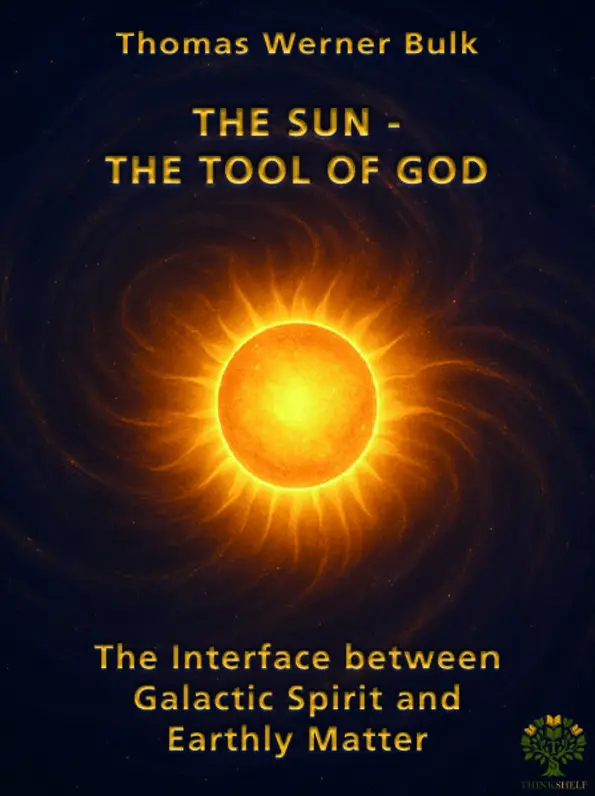This book is a journey into the fundamental questions of existence:
How does matter arise? What is information? What role does the Sun play as an interface between the galactic spirit and the visible world?
Through a compelling blend of modern physics (quantum field theory, black holes, photons, quarks) and spiritual concepts such as creation, consciousness, and transcendence, this work builds a holistic model that unites scientific insight with philosophical depth and poetic language.
Table of Contents
- Foreword
- In the Breath of Light
Objectives and Key Themes
This book aims to bridge the gap between scientific understanding and spiritual intuition, exploring the Sun's role as a mediator between the cosmos and life. It utilizes modern scientific insights alongside spiritual perspectives and ancient wisdom to offer a new theoretical framework.
- The Sun as a conscious mediator between the cosmos and life.
- The interconnectedness of matter, spirit, and information.
- The role of fundamental particles (quarks, gluons, photons) in cosmic creation.
- The presence of ancient wisdom and purpose within the universe.
- The integration of scientific and spiritual perspectives.
Chapter Summaries
Foreword: This foreword sets the stage for the book, describing it as a journey through the visible and invisible realms. It highlights the work's intention to integrate modern scientific understanding with spiritual intuition, ancient wisdom, and new theories. The author invites the reader to view the Sun not simply as a celestial body, but as a conscious entity facilitating interaction between the cosmos and life on Earth. This sets the tone for the book's overarching theme of exploring the interconnectedness between scientific and spiritual perspectives on the universe and its origins.
In the Breath of Light: This chapter delves into the origins of matter, tracing it back to the early universe. It describes the creation of quarks, gluons, and photons from the boundless field of becoming, attributing purpose and information to each particle. The chapter emphasizes the interconnectedness of these fundamental particles, highlighting how gluons facilitate cosmic interactions, the Higgs field introduces gravity, and photons carry information and embody the spirit of the galaxy. The key argument is that matter is not merely inert, but imbued with a history, memory, and intrinsic connection to the cosmos. The "breath of light" metaphor illustrates the vitality and inherent consciousness within even the smallest constituents of the universe, connecting the seemingly disparate realms of the spiritual and the physical.
Keywords
Sun, cosmos, spirit, matter, information, quarks, gluons, photons, Higgs field, gravity, ancient wisdom, scientific insights, spiritual intuition, interconnectedness, creation, origin.
Frequently asked questions
What is the main goal of the book previewed here?
The book aims to bridge the gap between scientific understanding and spiritual intuition, exploring the Sun's role as a mediator between the cosmos and life. It integrates modern scientific insights with spiritual perspectives and ancient wisdom to offer a new theoretical framework.
What are the key themes explored in the book?
The key themes include:
- The Sun as a conscious mediator between the cosmos and life.
- The interconnectedness of matter, spirit, and information.
- The role of fundamental particles (quarks, gluons, photons) in cosmic creation.
- The presence of ancient wisdom and purpose within the universe.
- The integration of scientific and spiritual perspectives.
What is the Foreword about?
The foreword sets the stage for the book, describing it as a journey through the visible and invisible realms. It emphasizes the integration of scientific understanding with spiritual intuition, ancient wisdom, and new theories. It introduces the idea of the Sun as a conscious entity facilitating interaction between the cosmos and life on Earth.
What is the chapter "In the Breath of Light" about?
This chapter explores the origins of matter, tracing it back to the early universe and the creation of quarks, gluons, and photons. It attributes purpose and information to each particle and highlights their interconnectedness. It argues that matter is imbued with a history, memory, and connection to the cosmos.
What are some of the keywords associated with this book?
The keywords include: Sun, cosmos, spirit, matter, information, quarks, gluons, photons, Higgs field, gravity, ancient wisdom, scientific insights, spiritual intuition, interconnectedness, creation, origin.
What is the significance of the Sun in this book?
The Sun is presented not merely as a celestial body, but as a conscious mediator between the cosmos and life on Earth, embodying the interconnectedness of scientific and spiritual perspectives.
Does the book address the nature of fundamental particles?
Yes, the book discusses the role of fundamental particles like quarks, gluons, and photons in cosmic creation, attributing purpose and information to them.
What kind of perspectives does the book combine?
The book combines modern scientific insights, spiritual perspectives, and ancient wisdom.
- Quote paper
- Thomas Werner Bulk (Author), 2025, The Sun - The Tool of God, Munich, GRIN Verlag, https://www.grin.com/document/1590327



